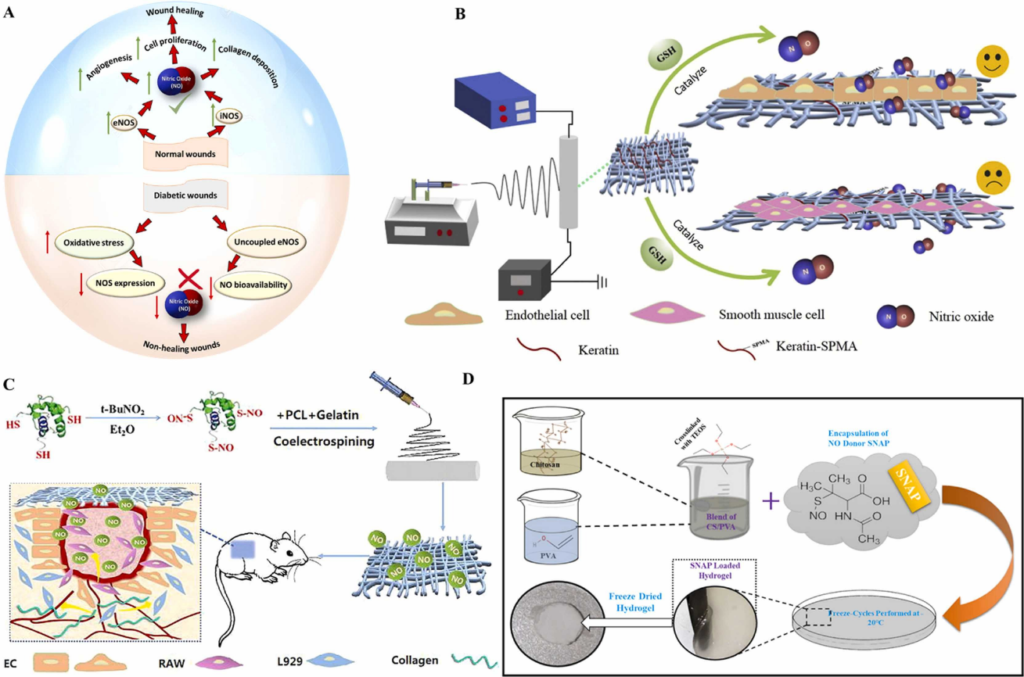
Enhancing Wound Healing with Nitric Oxide-Releasing Biomaterials
Nitric oxide (NO)-releasing biomaterials have gained significant attention in the field of wound healing due to the versatile and beneficial effects of NO on various stages of the wound repair process. NO is a signaling molecule that plays a crucial role in the regulation of inflammation, angiogenesis, and tissue regeneration. Incorporating NO-releasing biomaterials into wound dressings and scaffolds can provide sustained and controlled release of NO, promoting a favorable microenvironment for wound healing. Here are some key aspects of NO-releasing biomaterials for promoting wound healing:
Anti-Inflammatory Effects:
NO has anti-inflammatory properties that can help modulate the inflammatory response during the early stages of wound healing. The controlled release of NO can regulate immune cell function and reduce excessive inflammation, creating an environment conducive to healing.
Angiogenesis:
NO is a potent vasodilator and promotes angiogenesis, the formation of new blood vessels. Improved blood supply to the wound site enhances oxygen and nutrient delivery, facilitating tissue repair. NO-releasing biomaterials can stimulate angiogenesis, particularly beneficial in chronic wounds with poor blood circulation.
Antimicrobial Effects:
NO exhibits antimicrobial activity, helping to prevent or control infections at the wound site. This is particularly important in the initial stages of wound healing when the risk of infection is high. NO-releasing biomaterials contribute to a more sterile wound environment.
Collagen Synthesis and Matrix Deposition:
NO plays a role in collagen synthesis and deposition, contributing to the formation of a structurally sound extracellular matrix. This is essential for tissue remodelling and the development of a functional scar.
Cell Proliferation and Migration:
NO promotes the proliferation and migration of various cell types involved in wound healing, including fibroblasts and endothelial cells. These effects are crucial for the regeneration of damaged tissues.
Chronic Wound Healing:
NO-releasing biomaterials are particularly relevant in the context of chronic wounds, where the normal healing process is impaired. Conditions like diabetic ulcers and pressure sores may benefit from NO-based therapies to accelerate healing.
Controlled Release Systems:
Various biomaterials, such as hydrogels, nanoparticles, and dressings, can serve as carriers for NO release. These materials provide a controlled and sustained release of NO, ensuring a prolonged therapeutic effect.
Biocompatibility and Safety:
The biocompatibility and safety of NO-releasing biomaterials are crucial considerations. Ensuring that the materials do not cause adverse reactions or toxicity is essential for their clinical application.

Clinical Applications:
NO-releasing biomaterials are being investigated for use in wound dressings, scaffolds, and other wound care products. Clinical trials are ongoing to evaluate the efficacy and safety of these materials in promoting wound healing in various patient populations.
In summary, NO-releasing biomaterials represent a promising avenue for enhancing wound healing by leveraging the multifaceted roles of NO in the wound repair process. Ongoing research aims to optimize the design and application of these materials for effective and safe clinical use.
